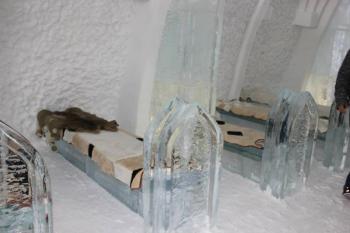QUEBEC CITY—It’s a long road up to Jackman. North of Skowhegan, Route 201 follows the weaving Kennebec River upstream into a prickling sea of dark spruce trees. At The Forks, the road hops across the icy rapids and heads off through the snowbound hills of Western Maine. The forest closes in on either side of the highway, and traffic consists only of the occasional logging truck. Moose-warning signs dot the roadside every few miles. The frontier between Canada and the United States is the longest unguarded border in the world, and the little Customs building north of Jackman feels powerless, almost humorous, in the midst of such a vast forest.
Just as the road seems to stretch into eternity through this pine-clad purgatory, the mountains flatten into rolling hills and the woods part to reveal scattered houses, then towns, then a bustling metropolis where speed limits are posted in kilometers and the road signs are in French. It’s always a surprise to stumble out of the woods and into the bustling, exotic metropolis of Québec City.
As a former Rotary exchange student, or rebound, I have the privilege of participating in Youth Exchange Program (YEP) events here at home. The Rotary district that includes the midcoast also encompasses most of Maine as well as the Province of Québec, placing it in a rare category of international, bilingual districts. Each year, the YEPs from both sides of the border come together for various events, including a fall orientation in Maine. This past weekend, three local Rotarians and nine exchange students tackled the six-hour drive to Québec for the Carnival. Five other local rebounds and I went along for the ride.
On our first night in Québec, we joined forces with our Canadian counterparts—about 20 altogether—for a night of tubing. This was an advanced level of tubing the likes of which I had never before experienced. There was not one chute, but rather a small mountain dedicated entirely to tubing, complete with rope pulls and more than a dozen trails of varying steepness. It was a frigid night and the wind raked the slopes with arctic fury. Nevertheless, the place was hopping, a testament to the Québecois’ unflinching approach to their brutal winters.
There was much worrying among the Québecois Rotarians as to whether my own coat would keep me warm enough. I am a Mainer and accustomed to being viewed as rugged by the rest of the country, so naturally I took this as a slight offense to my own preparedness. However, Québec is noticeably colder than Maine, and the Québecois are a remarkably hearty and prepared people. They have to be, otherwise they wouldn’t live in Québec.
Saturday morning dawned grey and chilly. We ate breakfast at our hostel, which was also a school, before loading into a bus for a visit to the Ice Hotel. The Ice Hotel is one of the world's most famous ice structures.
It is also arguably Québec City’s most iconic building after the Chateau Frontenac, which, though it is decidedly less avant-garde, does offer year-round accommodations. Regardless, the Ice Hotel is truly a remarkable structure, and the details of each room—a bed shaped like a Viking longboat here, a relief carving of a Buddhist temple there—are mind boggling. But what is most striking about the hotel is its heroic pathos. While exploring the hotel’s endless hallways, examining the ice chandelier in the lobby, or relaxing in one of the ornately carved ice pews in the adjoining chapel, one cannot help but think of the coming spring, when the Viking bed will begin to drip and the whole structure will eventually melt into the ground.
I quelled my sorrows with sirop d’erable, or maple syrup. At a sugar shack outside the hotel, I ordered a maple sugar toffee, intrigued as to what it could be. A boy came out of the shack with a vat of steaming maple syrup and ladled some out in a line on a shelf of snow reserved for that purpose. He handed me a tongue depressor and instructed me to wait 20 seconds, then roll the semi-congealed syrup around the stick. Half a minute later I was sucking contentedly on one of the most delicious popsicles I’ve ever tasted, all gloomy thoughts washed from my mind.
The culinary adventures continued at lunch. The Québecois Rotarians brought us to a local poutine joint. Poutine, a signature Canadian delicacy, is essentially a pile of french fries interspersed with lumps of cheese curds and smothered liberally with sweet gravy. Walking in the cold builds up an appetite, so I received my poutine with much joy. My arteries, though, were less thrilled, and protested as I dug into the gravy-soaked fries. By the time I hit the cheese curds they had packed up shop and were fleeing for the border.
We were then turned loose into the city to walk off the poutine while exploring the Old City and the outdoor Carnival events.
Québec’s Old City is truly a marvelous place. For me, it quenched a thirst for pedestrian streets, ancient churches, and cobblestone alleys that have been absent in my life since I left Belgium last July. Guided by Élodie, a rebound from Québec who spent last year on exchange in Japan, my friends from Maine and I scurried along the charming city blocks. We made our way to the wall the surrounds the Old City, and descended the precipitous, snow-covered stairway that leads to a tangle of pedestrian streets and touristy shops at the base of the wall. Then it was back up the stairs to enjoy panoramic views of the ice-choked St. Lawrence River from the shadow of the imposing bulwarks of the Chateau Frontenac. The narrow streets and stone buildings seemed natural under a blanket of snow, and the Old City buzzed with human energy despite the excruciating cold.
Having satisfied our thirst for old things built by Europeans, we climbed the hill—everything is uphill in Québec—to the Plains of Abraham, where in 1759 the British wrested rule of Canada from the French in a battle lasting 30 minutes. Now, the Plains are used as the principle outdoor venue for the Carnival celebrations. A forest of tents, sugar shacks, ice sculptures, and other attractions sprung from the snowy plains. We slipped in and joined the throngs of bundled people shuffling about the scene.
The entire city seemed to be in attendance, and for good reason. Among the attractions were ornate ice sculptures, maple sugar shacks, miniature toboggan shoots, a castle made entirely of ice, live music, a dogsled course, and bars serving Caribou, a popular liquor intended to heat the stomach. Despite the overwhelming excitement of the scene, our Élodie seemed wholly unenthused. After a short while spent strolling through the Plains, she suggested finding somewhere to warm up. “It’s just too cold,” she said. We had lasted barely longer than the French had in 1759.
As we were leaving the Plains, Élodie gestured off toward a thicket of tents and asked if we wanted to see the polar bear before we left. We responded with a resounding “Yes.” I squinted in the direction she was pointing, thrilled at the prospect of seeing such a beautiful and powerful animal in person and thinking that the Québecois had really outdone themselves on this one. Then Élodie laughed.
“Just kidding,” she said. “You guys didn’t actually believe we had polar bears here, did you?”
After our walk through the city, our group of roughly 30 current and former exchange students warmed up in the Hilton’s heated outdoor pool. Rotary has a way of making things like this happen, and in this respect is somewhat like a benevolent Mafia. I have been involved with the organization for two and a half years, as an exchange student and honorary member of clubs on both sides of the Atlantic, and have thus had considerable time to observe this phenomenon. Rotary was founded as a networking organization for businessmen. It has since grown into a global organization dedicated to promoting charity and community service on the local, national, and international levels. Through all this, some important aspects of the original businessmen’s club remain, and the Youth Exchange Program takes full advantage of the Rotary network.
For example, when we needed transportation for our trip to Québec. Not to worry, a Rotarian over at Dutch Chevrolet in Belfast supplied some vans. One of the Quebecois Rotarians has a connection with a school that rents its top two floors as a hostel, so he was able to hook us up with affordable lodging. What about food? Listen—Denny, one of the Québecois Rotarians, has some friends in the poutine business that owe him a favor. How about a relaxing swim after walking around the city? The local Rotary club meets at the Hilton, so they’ll hook you up with the pool guys. Go on, enjoy the sauna. We’ve got you covered.
That night, while eating dinner at one of the Rotarian’s houses, our meal was interrupted by the arrival of the bonhomme de Carnaval, the Carnival’s jolly snowman mascot. The seven-foot-tall bonhomme pranced into the living room, did a dance, then posed for pictures with the group.
I asked one of the Rotarians how our hosts had arranged for such a high profile guest.
“She was once Miss Québec,” he said of our hostess. “She knows people.”
After dinner we joined thousands of people leaving their warm, cozy homes to descend into the glacial night to witness the Carnival’s crowning jewel: the parade. There was some grumbling about going out into the cold again, but, as ever, the Québecois did not fail to impress.
The air of the snowbound neighborhood was rent by the honking of countless vuvuzelas, an instrument associated more closely with Brazilian soccer stadiums than wintertime Canadian parades. Spectators lined the road, fidgeting anxiously as the lights and sounds of the parade drew closer.
The event was more like a composition of mobile theatre performances than a parade. First, a dance troupe pranced by wearing ten-foot-tall balloon hats that resembled massive bowling pins. Shortly behind them came a flatbed truck with drummers and miniature volcanoes that erupted in gas flares every few seconds. A real-life Mary Poppins trundled passed, attached to a swiveling crane that swung her out around the cab of her float every few minutes. On one tropical-themed float, acrobats performed flips and twists on a trampoline as samba music blasted from unseen speakers. Another float featured a smiling orange octopus the size of a small house.
Some of the performances were interactive, like the mock auction in which a bellowing auctioneer sold people dressed as famous paintings to members of the crowd. The whole event took a turn for the surreal when a massive purple fish wheeled by, apparently of its own accord, while speakers in its gaping mouth repeated “Nom nom nom, I am going to get you!” A smiling bonhomme brought up the rear of the parade, waving from an elevated pedestal as he passed.
Even in Maine, a state where cold is the norm and ruggedness is a source of pride, life slows down in winter. Shops close, the tourists—bless them—retreat to more hospitable climes, and even locals spend more time by the woodstove. The Québecois, on the other hand, seem to feed off of the cold. Indeed, they embrace winter by sculpting snow, freezing maple syrup, and erecting habitable structures of ice. Winter is like a dare that only excites the Québecois into proving to the world that marrow-freezing temperatures will only make them more determined celebrate the outdoors and explore their beautiful city. There must be something in those cheese curds.
Ari Snider is a senior at Belfast Area High School


 .jpg)




































